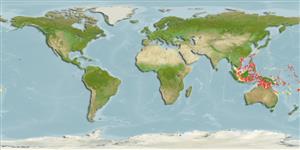>
Gobiiformes (Gobies) >
Gobiidae (Gobies) > Gobiinae
Etymology: Amblyeleotris: Greek, amblys = darkness + The name of a Nile fish, eleotris (Ref. 45335); biguttata: Name from Latin meaning two spots, for the prominent black spots on the chin..
More on author: Randall.
Environment: milieu / climate zone / depth range / distribution range
Écologie
marin démersal; profondeur 11 - 50 m (Ref. 57552). Tropical
Western Pacific: Solomon Islands and New Caledonia.
Taille / Poids / Âge
Maturity: Lm ? range ? - ? cm
Max length : 10.4 cm TL mâle / non sexé; (Ref. 90102)
Description synthétique
Morphologie | Morphométrie
Épines dorsales (Total): 7; Rayons mous dorsaux (Total): 13; Épines anales 1; Rayons mous anaux: 13; Vertèbres: 25. Diagnosis: Dorsal rays VI+I, 13; anal rays I, 13; pectoral rays 19; pelvic fins joined by membrane to tips of fifth rays; pelvic frenum present; fourth pelvic ray longest; fifth pelvic ray branching twice. Longitudinal scale series 91-103; no median predorsal scales; scales on side of nape extending to above middle of opercle. Gill opening reaching forward to a vertical about two-thirds orbit diameter behind eye. Body depth 5.8-6.1 in SL; head length 3.6-3.8 in SL; caudal fin pointed and long, 2.2-2.6 in SL. Pale brown dorsally, white ventrally, with three indistinct brown bars on body, and a slightly oblique brown bar from nape across opercle; pale interspaces with small brown blotches, faintly interconnected; a pair of prominent black spots on chin; dorsal fins yellowish grey, the first dorsal with small irregular dark-edged pale blue spots and orange tipped spines, the second dorsal with a broad yellow border containing small dark-edged pale blue spots, the rays tipped with orange; caudal fin with a vertically elongate diffuse brown spot on base (Ref. 57552).
The species inhabits silty sand areas and is associated with unidentified alpheid shrimp, where this species takes refuge in the shrimp's burrow (Ref. 57552).
Life cycle and mating behavior
Maturité | Reproduction | Frai | Œufs | Fécondité | Larves
Randall, J.E., 2004. Five new shrimp gobies of the genus Amblyeleotris from islands of Oceania. aqua, J. Ichthyol. Aquat. Biol. 8(2):61-78. (Ref. 57552)
Statut dans la liste rouge de l'IUCN (Ref. 130435)
Menace pour l'homme
Harmless
Utilisations par l'homme
Plus d'informations
PaysZones FAOÉcosystèmesOccurrencesIntroductionsStocksÉcologieRégime alimentaireÉléments du régime alimentaireConsommation alimentaireRation
Noms communsSynonymesMétabolismePrédateursÉcotoxicologieReproductionMaturitéFraiRassemblement de ponteFéconditéŒufsDéveloppement de l'œuf
Taille/ÂgeCroissanceLongueur-poidsLongueur-longueurFréquences de longueursMorphométrieMorphologieLarvesDynamique des populations larvairesRecrutementAbondanceBRUVS
RéférencesAquacultureProfil d'aquacultureSouchesGénétiqueElectrophoresesHéritabilitéPathologiesTraitementNutrientsMass conversion
CollaborateursImagesStamps, Coins Misc.SonsCiguateraVitesseType de nageSurface branchialeOtolithesCerveauxVision
Outils
Articles particuliers
Télécharger en XML
Sources Internet
Estimates based on models
Preferred temperature (Ref.
123201): 25.8 - 29, mean 27.8 °C (based on 48 cells).
Phylogenetic diversity index (Ref.
82804): PD
50 = 0.5000 [Uniqueness, from 0.5 = low to 2.0 = high].
Bayesian length-weight: a=0.00708 (0.00333 - 0.01504), b=3.09 (2.92 - 3.26), in cm total length, based on LWR estimates for this (Sub)family-body shape (Ref.
93245).
Niveau trophique (Ref.
69278): 3.3 ±0.4 se; based on size and trophs of closest relatives
Résilience (Ref.
120179): Haut, temps minimum de doublement de population inférieur à 15 mois (Preliminary K or Fecundity.).
Fishing Vulnerability (Ref.
59153): Low vulnerability (10 of 100).
